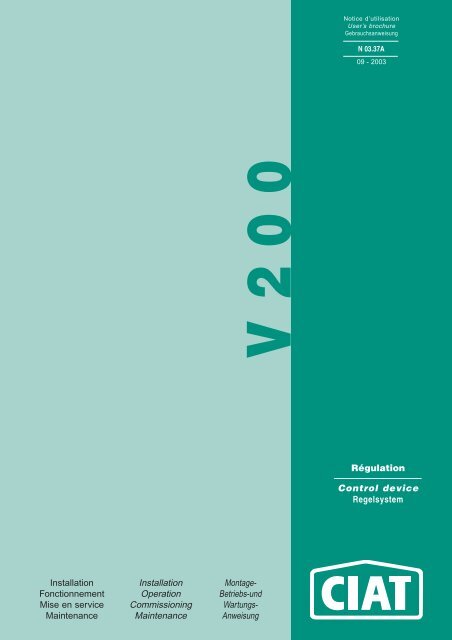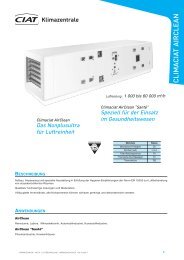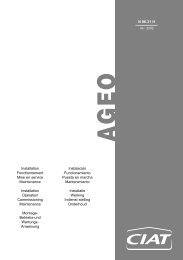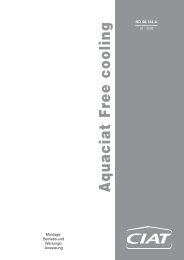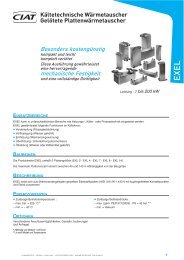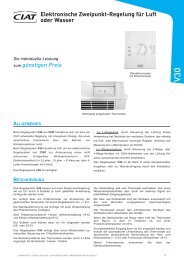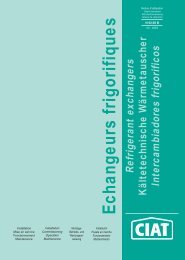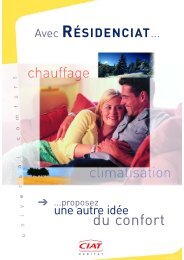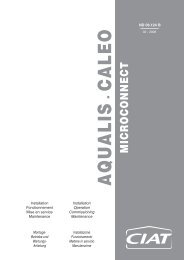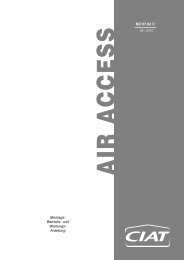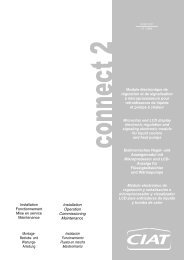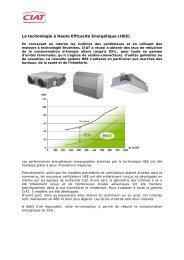Installation Fonctionnement Mise en service Maintenance ... - CIAT
Installation Fonctionnement Mise en service Maintenance ... - CIAT
Installation Fonctionnement Mise en service Maintenance ... - CIAT
Create successful ePaper yourself
Turn your PDF publications into a flip-book with our unique Google optimized e-Paper software.
<strong>Installation</strong><br />
<strong>Fonctionnem<strong>en</strong>t</strong><br />
<strong>Mise</strong> <strong>en</strong> <strong>service</strong><br />
Maint<strong>en</strong>ance<br />
<strong>Installation</strong><br />
Operation<br />
Commissioning<br />
Maint<strong>en</strong>ance<br />
V200<br />
Montage-<br />
Betriebs-und<br />
Wartungs-<br />
Anweisung<br />
Notice d’utilisation<br />
User’s brochure<br />
Gebrauchsanweisung<br />
N 03.37A<br />
09 - 2003<br />
Régulation<br />
Control device<br />
Regelsystem
Généralités<br />
La régulation V200 est une régulation <strong>CIAT</strong>,<br />
conçue pour piloter les unités terminales de<br />
climatisation non autonomes (V<strong>en</strong>tilo-convecteurs,<br />
UTA, Cassettes,...) pour des applications<br />
2 tubes, 2 tubes / 2 fils, 4 tubes fonctionnant<br />
<strong>en</strong> air recyclé.<br />
Elle permet de respecter une programmation<br />
horaire (raccordem<strong>en</strong>t à 1 ou 2 horloges, <strong>en</strong><br />
option) et d'assurer une fonction maître /<br />
esclave. Elle pilote des moteurs de vannes<br />
thermiques (moteurs 3 pts <strong>en</strong> option).<br />
Le système V200 se compose d'un régulateur<br />
intégré à l'unité terminale et d'un terminal<br />
utilisateur permettant de régler les consignes<br />
et les modes de fonctionnem<strong>en</strong>ts.<br />
Le terminal est disponible <strong>en</strong> version murale<br />
(à raccorder au régulateur par l'installateur)<br />
ou <strong>en</strong>castrée (montée et raccordée <strong>en</strong> usine)<br />
Principales fonctionnalités :<br />
- Action PI : l<strong>en</strong>te ou rapide<br />
- Commande d'un v<strong>en</strong>tilateur 3 vitesses,<br />
automatique ou manuelle.<br />
- Commutation chauffage / refroidissem<strong>en</strong>t<br />
automatique, avec sonde change over (application<br />
2 tubes).<br />
- 2 Entrées libres de pot<strong>en</strong>tiel pour contact de<br />
f<strong>en</strong>être, horloge ou détecteur de prés<strong>en</strong>ce.<br />
- Trois régimes : Confort / Economie / Hors gel.<br />
<strong>Fonctionnem<strong>en</strong>t</strong><br />
La régulation est de type Proportionnel et<br />
Intégrale. Elle agit à la fois sur la (les)<br />
vanne(s), la batterie électrique, les trois vitesses<br />
de v<strong>en</strong>tilation.<br />
Ouverture de vanne calculée par l ’algorithme PI<br />
PI algorithm calculates wh<strong>en</strong> the valve is to be op<strong>en</strong>ed<br />
V<strong>en</strong>tilöffnung berechnet durch Algorithmus PI<br />
100%<br />
100%<br />
TC TF 100%<br />
Zone neutre Réglable de 3 à 6K<br />
Neutral zone with 3 to 6K adjustable setting<br />
Neutralbereich regelbar von 3 bis 6K<br />
En sortie de chauffage ou rafraîchissem<strong>en</strong>t,<br />
le v<strong>en</strong>tilateur continue de fonctionner<br />
p<strong>en</strong>dant 4 min.<br />
La puissance de la batterie électrique<br />
év<strong>en</strong>tuelle est modulée par un signal<br />
chrono-proportionnel sur une base de<br />
temps de 4 min 15 s.<br />
G<strong>en</strong>eralities<br />
The V200 is a <strong>CIAT</strong> control device, designed<br />
to control non autonomous air conditioning<br />
terminal units (fan-coil units, UTA,<br />
Cassettes,...). for two-pipe, two-pipe/two-wire,<br />
four-pipe applications operating with recycled<br />
air.<br />
It <strong>en</strong>ables a time programming (optional<br />
hook-up to 1 or 2 clocks) and allows the<br />
Master/ Slave function. The V200 drives the<br />
thermal valve actuators (3 pts actuators available<br />
as an option).<br />
The V200 consists of a controller built into the<br />
terminal unit and a user terminal for specifying<br />
the set points and operating modes.<br />
The terminal can be supplied in a wall-mounted<br />
version (to be connected to the controller by the<br />
installation <strong>en</strong>gineer) or as an embedded unit<br />
(fitted and connected in the factory).<br />
Main functionalities:<br />
- PI action: slow or fast<br />
- 3-speed fan control, auto or manual.<br />
- Auto heating/cooling change-over, with s<strong>en</strong>sor<br />
(for 2-pipe applications).<br />
- 2 pot<strong>en</strong>tial free inputs available for window,<br />
clock or pres<strong>en</strong>ce detector contact.<br />
- Three modes: Comfort/Economy/Anti-freeze.<br />
Working<br />
This control device is of the integral proportional<br />
type. It acts at the same time on the<br />
valve(s), electrical battery and the three<br />
speeds of v<strong>en</strong>tilation.<br />
Bande proportionnelle<br />
Proportional band<br />
Proportionalbereich<br />
After the thermostat shuts off (heating or<br />
cooling), the fan continues to operate for<br />
approx. 4 min.<br />
The capacity of the optional electrical<br />
battery is regulated by a chrono-proportional<br />
signal on a 4 mn 15 s time basis.<br />
2<br />
Allgemein<br />
Das Regelsystem V200 ist eine <strong>CIAT</strong>-Regelung,<br />
sie di<strong>en</strong>t zur Verwaltung von Klimakonvektor<strong>en</strong>,<br />
Einheit<strong>en</strong> zur Luftbehandlung in Form von 2-<br />
Leiter- 2 Leiter + E-Heïzung oder 4-<br />
Leitersystem<strong>en</strong> mit Umluft.<br />
Die Regelung lässt eine Zeitprogrammierung<br />
(Anschließ<strong>en</strong> an 1 oder 2 Uhr<strong>en</strong>, in Option) sowie<br />
ein<strong>en</strong> Master-/Slave-Betrieb zu. Sie regelt die<br />
Motor<strong>en</strong> der Thermische v<strong>en</strong>tile (3 Punkt-Motor<strong>en</strong><br />
in Option).<br />
Das System V200 umfasst ein<strong>en</strong> Regler, der in<br />
der Klimakonvektor integriert ist und ein<strong>en</strong><br />
B<strong>en</strong>utzerterminal zur Ermöglichung des<br />
Einstell<strong>en</strong>s der Sollwerte und der Funktionsart<strong>en</strong>.<br />
Das Bedi<strong>en</strong>gerät ist zur Wand-Anbringung (der<br />
Installateur muss es mit dem Regler verbind<strong>en</strong>)<br />
oder eingebaut erhältlich (im Werk montiert und<br />
angeschloss<strong>en</strong>).<br />
Hauptfunktionalität<strong>en</strong>:<br />
- Wirkung PI: langsam oder schnell<br />
- Automatische oder manuelle Steuerung eines<br />
V<strong>en</strong>tilators mit 3 Drehzahl<strong>en</strong>.<br />
- Automatikumschalt<strong>en</strong> Heiz<strong>en</strong> / Kühl<strong>en</strong> mit<br />
Change-over Fühler (Anw<strong>en</strong>dung 2 Leiter).<br />
- 2 pot<strong>en</strong>zialfreie Eingänge zum F<strong>en</strong>sterkontakt,<br />
Schalthur oder Präs<strong>en</strong>zs<strong>en</strong>sor.<br />
- Drei Betriebszustände: Komfort/Ersparnis/Frostfrei.<br />
Betriebs<br />
Die Regelung wird proportional und integral ausgeführt.<br />
Sie führt gleichzeitig die V<strong>en</strong>tile, die<br />
elektrisch<strong>en</strong> Register und die Drehzahl für d<strong>en</strong><br />
V<strong>en</strong>tilator.<br />
Vitesse de v<strong>en</strong>tilation <strong>en</strong> coupure de v<strong>en</strong>tilation zone neutre<br />
Fan speed during fan cutoff in neutral zone<br />
V<strong>en</strong>tilations-Drehzahl bei V<strong>en</strong>tilationsabschaltung Neutralbereich<br />
3<br />
2<br />
1<br />
0<br />
100%<br />
TC TF 100%<br />
80% 50% 10% 10% 50% 80%<br />
Zone neutre Réglable de 3 à 6K<br />
Neutral zone with 3 to 6K adjustable setting<br />
Neutralbereich regelbar von 3 bis 6K<br />
Bande proportionnelle<br />
Proportional band<br />
Proportionalbereich<br />
Der V<strong>en</strong>tilator läuft nach dem Abschalt<strong>en</strong> noch<br />
ca.4 Minute weiter.<br />
Ein chrono-proportionnelles Signal moduliert die<br />
Leistung der ev<strong>en</strong>tuell<strong>en</strong> elektrisch<strong>en</strong> Batterie auf<br />
einer Zeitbasis von 4 Min 15 s.
Tous les calculs ont lieu dans le régulateur. Le<br />
terminal de commande permet de régler la<br />
température de consigne, de choisir <strong>en</strong>tre<br />
une v<strong>en</strong>tilation automatique ou manuelle, de<br />
sélectionner la marche ou la veille (fonction<br />
hors gel assurée) de l'appareil et év<strong>en</strong>tuellem<strong>en</strong>t<br />
de mesurer la température ambiante.<br />
Le raccordem<strong>en</strong>t <strong>en</strong>tre le terminal et le régulateur<br />
s'effectue par trois fils pour un boîtier<br />
<strong>en</strong>castré (vitesse de v<strong>en</strong>tilation, réglage<br />
consigne, sélection marche/arrêt) ou quatre<br />
fils pour un boîtier d'ambiance (vitesse de<br />
v<strong>en</strong>tilation, réglage consigne, sélection marche/arrêt,<br />
mesure de l'ambiance).<br />
2<br />
3<br />
Mode d'emploi<br />
Réglage de la température de consigne<br />
Le pot<strong>en</strong>tiomètre (1) permet de régler les<br />
consignes confort dans la plage prédéfinie.<br />
Lorsque le pot<strong>en</strong>tiomètre se trouve <strong>en</strong> face<br />
du point milieu, la consigne confort chaud est<br />
de 19 °C. La consigne confort froid varie de<br />
22 à 25 °C <strong>en</strong> fonction de la position des<br />
commutateurs D5 et D6 (voir paragraphe<br />
réglages sur site). Le pot<strong>en</strong>tiomètre <strong>en</strong> position<br />
extrême permet de régler les consignes<br />
dans une plage de ± 6 °C autour de ces<br />
valeurs.<br />
Réglage de la v<strong>en</strong>tilation<br />
En régime confort, l'utilisateur peut choisir<br />
<strong>en</strong>tre une v<strong>en</strong>tilation automatique sur 3 vitesses<br />
et une v<strong>en</strong>tilation manuelle <strong>en</strong> actionnant<br />
le sélecteur de vitesse du terminal (2).<br />
En vitesses automatiques, le régulateur<br />
<strong>en</strong>cl<strong>en</strong>che les vitesses de v<strong>en</strong>tilation <strong>en</strong> fonction<br />
de l'écart <strong>en</strong>tre la mesure de température<br />
et la consigne.<br />
En v<strong>en</strong>tilation manuelle, la v<strong>en</strong>tilation devi<strong>en</strong>t<br />
indép<strong>en</strong>dante de la température mesurée et<br />
reste constamm<strong>en</strong>t sur la vitesse sélectionnée.<br />
Si l'utilisateur sélectionne la petite vitesse de<br />
v<strong>en</strong>tilation, le rapport cyclique du chauffage<br />
électrique est limité à 50%. Si l'utilisateur<br />
sélectionne la vitesse moy<strong>en</strong>ne, le rapport<br />
cyclique est limité à 80%. Cette limitation du<br />
rapport cyclique a pour but d'éviter la surchauffe<br />
dans l'appareil.<br />
Remarque sur la v<strong>en</strong>tilation <strong>en</strong> zone neutre :<br />
Si le mode vitesse automatique est sélectionné,<br />
il est possible de choisir <strong>en</strong>tre deux fonctionnem<strong>en</strong>t<br />
<strong>en</strong> zone neutre :<br />
Si le commutateur D2=OFF, la v<strong>en</strong>tilation est<br />
arrêté <strong>en</strong> zone neutre mais une v<strong>en</strong>tilation<br />
périodique (qui <strong>en</strong>cl<strong>en</strong>che le v<strong>en</strong>tilateur p<strong>en</strong>dant<br />
20s à la vitesse 1) est réalisée toutes les<br />
30 min.<br />
Si le commutateur D2=ON, la v<strong>en</strong>tilation<br />
reste constamm<strong>en</strong>t <strong>en</strong> petite vitesse dans la<br />
zone neutre.<br />
All calculations are performed by the controller.<br />
The control box can be used to adjust the<br />
set point temperature, select auto or manual<br />
fan operation, put the system in run or standby<br />
mode (anti-freeze mode is guaranteed to<br />
run), or take a room-temperature reading.<br />
The terminal is connected to the controller by<br />
three wires (fan speed, changing the set<br />
point, switch on/off) on embedded units and<br />
by four wires (fan speed, set point adjustm<strong>en</strong>t,<br />
switching on/off, taking room temperature<br />
readings) on the wall-mounted version.<br />
1<br />
Operating instructions<br />
Adjusting the set point temperature<br />
Turn the control dial (1) to adjust the comfort<br />
mode temperature within the pre-defined<br />
range. Wh<strong>en</strong> the setpoint adjustm<strong>en</strong>t is in<br />
front of the middle point, the heating setpoint<br />
is 19°C. The cooling setpoint fluctuates from<br />
22 to 25°C according to D5 & D6 switches<br />
positions (see paragraph about onsite adjustm<strong>en</strong>ts).<br />
Wh<strong>en</strong> the setpoint adjustm<strong>en</strong>t is on<br />
the lower or on the higher position, setting<br />
temperatures fluctuates around ± 6 °C.<br />
Adjusting v<strong>en</strong>tilation<br />
In comfort mode, change the position of the<br />
fan speed switch (2) to operate either in 3speed<br />
auto fan mode or in manual mode.<br />
Auto speed mode: the differ<strong>en</strong>ce betwe<strong>en</strong> the<br />
actual temperature reading and the set point<br />
temperature determines the speed at which<br />
the controller drives the fan.<br />
Manual mode: the fan speed is constant<br />
and is not determined by the temperature<br />
reading.<br />
The duty cycle limit for the electric heater is<br />
50% wh<strong>en</strong> the fan speed selected in manual<br />
mode is low, and 80% for the medium speed<br />
setting. These restrictions prev<strong>en</strong>t the equim<strong>en</strong>t<br />
from overheating.<br />
Information on v<strong>en</strong>tilation in the neutral zone:<br />
Two neutral zone operations are available in<br />
auto fan mode:<br />
If the D2 switch is turned OFF, v<strong>en</strong>tilation is<br />
turned off in the neutral zone, but is switched<br />
on again (for 20 seconds in speed setting 1)<br />
every 30 minutes.<br />
If the D2 switch is turned ON, v<strong>en</strong>tilation<br />
continues at low speed in the neutral zone.<br />
3<br />
Alle Berechnung<strong>en</strong> find<strong>en</strong> im Regler statt. Das<br />
Steuerterminal erm glicht die Regelung der<br />
Sollwert-Temperatur, die Wahl zwisch<strong>en</strong> einer<br />
automatisch<strong>en</strong> oder manuell<strong>en</strong> Lüftung, die<br />
Auswahl der Betriebsart oder der Bereitschaft<br />
(Funktion frostfrei sichergestellt) des Geräts und<br />
ev<strong>en</strong>tuell die Messung der Raumtemperatur.<br />
Die Verbindung zwisch<strong>en</strong> dem Bedi<strong>en</strong>gerät und<br />
dem Regler erfolgt bei einem Einbaugehäuse durch<br />
drei Drähte (Lüfterdrehzahl, Sollwertregelung,<br />
Auswahl Betrieb/Stopp) oder vier Drähte bei einem<br />
Raumgehäuse (Lüfterdrehzahl, Sollwertregelung,<br />
Auswahl Betrieb/Stopp, Raum-Messung).<br />
Terminal <strong>en</strong>castré / Embedded terminal / Einbau-Bedi<strong>en</strong>gerät Terminal mural / Wall-mounted terminal / Wand-Bedi<strong>en</strong>gerät<br />
3<br />
2<br />
Bedi<strong>en</strong>ungsanleitung<br />
Regelung der Sollwert-Temperatur<br />
Das Pot<strong>en</strong>tiometer (1) ermöglicht die Regelung<br />
der Sollwerte Komfort im vordefiniert<strong>en</strong><br />
Bereich. W<strong>en</strong>n das Pot<strong>en</strong>tiometer sich in der<br />
Mitte seines Bereiches befindet, ist der Sollwert<br />
Heiz<strong>en</strong> auf 19°C eingestellt. Der Sollwert Kühl<strong>en</strong><br />
wird zwisch<strong>en</strong> 22 und 25°C abh ngig von der<br />
Position des Schalters D5 und D6 (siehe<br />
Paragraf<strong>en</strong> Regelung am Standort) eingestellt. Ist<br />
das Pot<strong>en</strong>tiometer auf einer extrem<strong>en</strong> Position<br />
( rechts oder links), variiert der Sollwert um ± 6°C.<br />
Regelung der Lüftung<br />
Der B<strong>en</strong>utzer kann in Betriebsart Komfort zwisch<strong>en</strong><br />
einer Automatik Lüftung mit 3 Drehzahl<strong>en</strong> und einer<br />
manuell<strong>en</strong> Lüftung durch Bet tigung des<br />
Drehzahlwahlschalters von Bedi<strong>en</strong>gerät 2 wähl<strong>en</strong>.<br />
Der Regler schaltet in Automatikdrehzahl<strong>en</strong> die<br />
V<strong>en</strong>tilationsdrehzahl<strong>en</strong> in Funktion der<br />
Abweichung zwisch<strong>en</strong> der Temperaturmessung<br />
und dem Sollwert ein.<br />
In manueller Lüftung ist die V<strong>en</strong>tilation unabhängig<br />
von der gemess<strong>en</strong><strong>en</strong> Temperatur und bleibt<br />
ständig in der gewählt<strong>en</strong> Drehzahl.<br />
W<strong>en</strong>n der B<strong>en</strong>utzer die kleine Lüftungs-Drehzahl<br />
wählt, wird das zyklische Verhältnis der elektrisch<strong>en</strong><br />
Heizung auf 50% begr<strong>en</strong>zt. W<strong>en</strong>n der B<strong>en</strong>utzer die<br />
mittlere Lüftungs-Drehzahl wählt, wird das zyklische<br />
Verhältnis auf 80% begr<strong>en</strong>zt. Mit dieser Begr<strong>en</strong>zung<br />
des zyklisch<strong>en</strong> Verhältnisses soll die<br />
Geräteüberhitzung vermied<strong>en</strong> werd<strong>en</strong>.<br />
Anmerkung zur Lüftung im Neutralbereich:<br />
Bei Wahl des Automatikdrehzahl-Modus kann<br />
zwisch<strong>en</strong> zwei Funktionsart<strong>en</strong> im Neutralbereich<br />
gewählt werd<strong>en</strong>:<br />
W<strong>en</strong>n der Schalter D2=OFF ist, wird die Lüftung<br />
im Neutralbereich gestoppt, aber eine periodische<br />
Lüftung (welche d<strong>en</strong> V<strong>en</strong>tilator währ<strong>en</strong>d 20s<br />
bei Drehzahl 1 einschaltet) erfolgt alle 30<br />
Minut<strong>en</strong>.<br />
W<strong>en</strong>n der Schalter D2=ON ist, bleibt die Lüftung<br />
dauernd in niedriger Drehzahl im Neutralbereich.<br />
1
Réglage du régime de fonctionnem<strong>en</strong>t<br />
En positionnant l'interrupteur du terminal sur<br />
veille 3, le régulateur passe <strong>en</strong> mode hors gel.<br />
Une <strong>en</strong>trée contact de feuillure (bornes W /<br />
C5 sur le régulateur) permet égalem<strong>en</strong>t de<br />
passer <strong>en</strong> hors gel quand une f<strong>en</strong>être est<br />
ouverte. Le s<strong>en</strong>s d'action de ce contact (normalem<strong>en</strong>t<br />
ouvert ou normalem<strong>en</strong>t fermé) est<br />
configurable à l'aide du commutateur D3.<br />
Un passage <strong>en</strong> hors gel (interrupteur <strong>en</strong> position<br />
veille ou f<strong>en</strong>être ouverte) provoque un<br />
verrouillage du refroidissem<strong>en</strong>t et permet de<br />
maint<strong>en</strong>ir une température de 8 °C. Afin de<br />
réduire au maximum la consommation énergique<br />
<strong>en</strong> mode hors gel, les vitesses manuelles<br />
ne sont plus utilisables, le régulateur<br />
adapte automatiquem<strong>en</strong>t la v<strong>en</strong>tilation au<br />
juste besoin.<br />
Une <strong>en</strong>trée économie provoque un passage<br />
<strong>en</strong> réduit quand son contact est fermé. Elle<br />
peut être utilisée associée à une horloge programmable,<br />
à une clé, ...<br />
Un passage <strong>en</strong> économie (<strong>en</strong>trées E et C4<br />
court-circuitées) <strong>en</strong>traîne un décalage des<br />
consignes de 5K par rapport aux consignes<br />
confort. Afin de réduire au maximum la<br />
consommation énergique <strong>en</strong> mode économique,<br />
les vitesses manuelles ne sont plus<br />
utilisables, le régulateur adapte automatiquem<strong>en</strong>t<br />
la v<strong>en</strong>tilation au juste besoin.<br />
Mesure température<br />
d'air<br />
Le V200 offre la possibilité de mesurer la<br />
température de l'air au moy<strong>en</strong> d'une sonde de<br />
reprise ou d'une sonde d'ambiance.<br />
Dans la mesure où on peut choisir <strong>en</strong>tre les<br />
deux, il est préférable d'opter pour la sonde<br />
d'ambiance car elle donne une meilleure<br />
image de la température du local.<br />
La sonde d'ambiance est située à l'intérieur du<br />
boîtier de commande mural. Quand cette<br />
sonde est utilisée, il faut apporter une att<strong>en</strong>tion<br />
particulière à la disposition du terminal de commande<br />
dans le local (ne pas l'exposer au soleil,<br />
ni au dessus d'un appareil dégageant de la<br />
chaleur, le disposer sur une cloison intérieure).<br />
L'extrémité de la goulotte de passage des fils<br />
doit être thermiquem<strong>en</strong>t isolée.<br />
Caractéristiques des sondes utilisées<br />
par le V200<br />
Toutes les sondes utilisées par le V200<br />
(ambiance, reprise, change over) ont les<br />
mêmes caractéristiques. La formule pour calculer<br />
la résistance <strong>en</strong> fonction de la température<br />
est la suivante :<br />
R(T) = 990 [ 1 + 7.874 x 10-3 (T - 25) + 1.874<br />
x 10-5 (T - 25)2 ]<br />
avec R exprimée <strong>en</strong> Ohms et T exprimée <strong>en</strong> °C.<br />
Adjusting the operating mode<br />
The controller switches to anti-freeze mode<br />
wh<strong>en</strong> the terminal switch (3) is set to standby.<br />
A window contact (W/C5 controller terminals)<br />
also <strong>en</strong>ables switchover to anti-freeze mode<br />
wh<strong>en</strong> a window is op<strong>en</strong>.The D3 switch also<br />
sets the direction for this contact (normally<br />
op<strong>en</strong> or normally closed).<br />
Wh<strong>en</strong> the anti-freeze mode is activated<br />
(switch is in standby position or the window is<br />
op<strong>en</strong>), the cooling is locked and the temperature<br />
can be kept at a constant 8°C. The<br />
manual speed settings are overridd<strong>en</strong> in antifreeze<br />
mode to keep <strong>en</strong>ergy consumption at<br />
a minimum, and the controller automatically<br />
adjusts the fan setting to meet the necessary<br />
requirem<strong>en</strong>ts.<br />
Wh<strong>en</strong> an economy input contact is closed, a<br />
reduced setting is activated. The economy<br />
input can be used in conjunction with a programmable<br />
clock, a key, etc., ...<br />
Switching to economy mode (E and C4 inputs<br />
short-circuited) causes a 5K shift away from<br />
the comfort mode set point temperatures. The<br />
manual speed settings are overridd<strong>en</strong> in economy<br />
mode to keep <strong>en</strong>ergy consumption at a<br />
minimum, and the controller automatically<br />
adjusts the fan setting to meet the necessary<br />
requirem<strong>en</strong>ts.<br />
Measuring of the air<br />
temperature<br />
The V200 control device gives the possibility<br />
of measuring the air temperature through the<br />
means of an intake s<strong>en</strong>sor or an ambi<strong>en</strong>t s<strong>en</strong>sor.<br />
As it is possible to choose betwe<strong>en</strong> both of<br />
them, it is advisable to select the ambi<strong>en</strong>t<br />
s<strong>en</strong>sor as it gives a better accuracy of the<br />
room temperature.<br />
The ambi<strong>en</strong>t s<strong>en</strong>sor is located inside the control<br />
box. Wh<strong>en</strong> this s<strong>en</strong>sor is used, particular att<strong>en</strong>tion<br />
should be giv<strong>en</strong> to the location of the control<br />
box in the room ( Do not expose neither to the<br />
direct sun light, nor above a unit giving out heat,<br />
position it on an internal wall).<br />
The extremity of the wiring passage channel<br />
must be thermally insulated.<br />
150 cm<br />
Characteristics of the s<strong>en</strong>sors used<br />
by the V200<br />
All the s<strong>en</strong>sors used by the V200 (ambi<strong>en</strong>ce,<br />
intake, change-over) have the same characteristics.<br />
The formula to calculate the resistance<br />
as a function of the temperature is as<br />
follows :<br />
R(T) = 990 [ 1 + 7.874 x 10-3 (T - 25) + 1.874<br />
x 10-5 (T - 25)2 ]<br />
R is expressed in Ohms and T in °C.<br />
Température / Temperature / Temperatur °C 5 10 15 20 25 30 35<br />
Résistance / Resistance / Widerstand Ohms 842 877 914 951 990 1029 1070<br />
4<br />
Regelung der Funktionsart<br />
Beim Stell<strong>en</strong> des Bedi<strong>en</strong>ger teschalters auf<br />
Bereitschaft 3 geht der Regler in Modus frostfrei.<br />
Ein F<strong>en</strong>sterkontak (Klemm<strong>en</strong> W / C5 am Regler)<br />
ermöglicht eb<strong>en</strong>falls d<strong>en</strong> Übergang in frostfrei,<br />
w<strong>en</strong>n das F<strong>en</strong>ster off<strong>en</strong> ist. Die Wirkungsrichtung<br />
dieses Kontaktes (normalerweise off<strong>en</strong> oder normalerweise<br />
geschloss<strong>en</strong>) kann mit dem Schalter<br />
D3 konfiguriert werd<strong>en</strong>.<br />
Ein Übergang in frostfrei (Schalter in Stellung<br />
Bereitschaft oder F<strong>en</strong>ster off<strong>en</strong>) führt zu einer<br />
Verriegelung der Kühlung und ermöglicht das<br />
Halt<strong>en</strong> der Temperatur bei 8 °C. Zur maximal<strong>en</strong><br />
S<strong>en</strong>kung des Energieverbrauchs in Modus frostfrei<br />
sind die manuell<strong>en</strong> Drehzahl<strong>en</strong> nicht mehr<br />
b<strong>en</strong>utzbar, der Regler passt automatisch die<br />
V<strong>en</strong>tilation dem wahr<strong>en</strong> Bedarf an.<br />
Ein Eingang Ersparnis führt zum Übergang in<br />
abges<strong>en</strong>kt, w<strong>en</strong>n sein Kontakt geschloss<strong>en</strong> ist. Er<br />
kann in Verbindung mit einer Schaltuhr, einem<br />
Schlüssel b<strong>en</strong>utzt werd<strong>en</strong>...<br />
Ein Übergang in Ersparnis (Eingänge E und C4<br />
überbrückt) führt zu einer Verschiebung der<br />
Sollwerte bezog<strong>en</strong> auf die Komfort-Sollwerte um<br />
5K. Zur maximal<strong>en</strong> S<strong>en</strong>kung des<br />
Energieverbrauchs in Ersparnis-Modus sind die<br />
manuell<strong>en</strong> Drehzahl<strong>en</strong> nicht mehr b<strong>en</strong>utzbar, der<br />
Regler passt automatisch die V<strong>en</strong>tilation dem<br />
wahr<strong>en</strong> Bedarf an.<br />
Messung der<br />
Lufttemperatur<br />
Das V200-Gerät hat zwei Möglichkeit<strong>en</strong> für die<br />
Messung der Lufttemperatur, <strong>en</strong>tweder mit einem<br />
Rückluftfühler oder mit einem Raumtemperaturfühler.<br />
Falls ein<strong>en</strong> Auswahl möglich ist, ist es besser der<br />
Raumtemperature fühler auszuwähl<strong>en</strong>, da es ein<br />
besseres Ergebnis für die Raumtemperatur erzielt.<br />
Der Raumtemperaturfühler befindet sich im<br />
Bedi<strong>en</strong>gerät. Falls dieser Fühler b<strong>en</strong>utzt wird,<br />
müß<strong>en</strong> Sie die Lage des Bedi<strong>en</strong>gerätes im Raum<br />
beacht<strong>en</strong> (der Sonne nicht aussetz<strong>en</strong>, nicht über<br />
einem wärme<strong>en</strong>twickelnd<strong>en</strong> Gerät aufsetz<strong>en</strong>, an<br />
der Inn<strong>en</strong>wand installier<strong>en</strong>).<br />
Die End<strong>en</strong> der Kabeldurchgang müss<strong>en</strong> eine<br />
thermische Isolation hab<strong>en</strong>.<br />
K<strong>en</strong>nzeich<strong>en</strong> des V200 Fühlers<br />
R(T) = 990 [ 1 + 7.874 x 10 -3 (T - 25) + 1.874 x 10 -5 (T - 25) 2 ]<br />
Alle Fühler für V200 (Raumtemperatur, Umluft,<br />
change-over) hab<strong>en</strong> dieselb<strong>en</strong> K<strong>en</strong>nzeich<strong>en</strong>. Die<br />
Formel für die Berechnung des Widerstands ist<br />
abhängig von der Temperatur :<br />
Mit R in Ohm und T in °C<br />
Quelques valeurs : Some examples: Einige Werte:<br />
20 cm<br />
150 cm<br />
mini
Mesure température d'eau<br />
Les v<strong>en</strong>tilo-convecteurs 2 tubes chaud / froid<br />
dispos<strong>en</strong>t d'une sonde de mesure de température<br />
d'eau (ou sonde de change over).<br />
Celle-ci ne peut pas être utilisée sur des v<strong>en</strong>tilo-convecteurs<br />
munis de vannes 2 voies.<br />
Elle doit être placée <strong>en</strong> amont de la vanne 4<br />
voies (côté réseau d'eau) par l'installateur.<br />
Elle est fixée sur la tuyauterie au moy<strong>en</strong> de<br />
colliers électrici<strong>en</strong>s. Un isolant doit recouvrir à<br />
la fois la sonde et la tuyauterie.<br />
Pour détecter une température d'eau chaude,<br />
la sonde de change over doit mesurer une<br />
température d'au moins 25 °C. Pour détecter<br />
une température d'eau froide, la sonde doit<br />
détecter une température inférieure à 20 °C.<br />
Entre ces valeurs, le V200 garde <strong>en</strong> mémoire<br />
le dernier état (chaud ou froid) de l'eau.<br />
Att<strong>en</strong>tion : la sonde de change over mesure<br />
une température de contact de la tuyauterie.<br />
Il existe forcém<strong>en</strong>t une différ<strong>en</strong>ce <strong>en</strong>tre la<br />
température réelle de l'eau et cette température<br />
de contact. Le régime d'eau sera donc<br />
choisi de façon à garantir le basculem<strong>en</strong>t du<br />
change over.<br />
Si ri<strong>en</strong> n'est branché <strong>en</strong>tre C3 et S2, le régulateur<br />
<strong>en</strong> déduit que l'eau circulant dans la<br />
batterie est toujours froide. S'il y a un pont<br />
<strong>en</strong>tre ces bornes, le régulateur <strong>en</strong> déduit que<br />
l'eau est toujours chaude.<br />
Très important :<br />
la sonde est à disposer sur la tuyauterie d'arrivée<br />
d'eau. Elle doit être installée sur la<br />
tuyauterie avant son isolation.<br />
Measuring of the water<br />
temperature<br />
The heating/cooling two-pipe fan-coil units have a<br />
water temperature measuring s<strong>en</strong>sor (or changeover<br />
s<strong>en</strong>sor).This s<strong>en</strong>sor cannot be used on fan-coil<br />
units supplied with two-way valves. It must be positioned<br />
upstream from the four-way valves (on the<br />
water network side) by the installer. It is fixed on the<br />
piping with electrician collars.The s<strong>en</strong>sor and the<br />
piping must be both covered by an insulation.<br />
To detect a warm water temperature, the<br />
change-over s<strong>en</strong>sor must measure a temperature<br />
of 25 °C minimum. To detect a cold<br />
water temperature, the s<strong>en</strong>sor must measure<br />
a temperature lower than 20 °C.<br />
Betwe<strong>en</strong> these values, the V200 keeps in memory<br />
the last condition of the water temperature.<br />
Att<strong>en</strong>tion : The change-over s<strong>en</strong>sor measures<br />
the piping’s contact temperature. As a differ<strong>en</strong>ce<br />
betwe<strong>en</strong> the real water temperature<br />
and that contact temperature does exist, the<br />
water temperature will be selected in order to<br />
guarantee the tilting of the change-over.<br />
If nothing is connected betwe<strong>en</strong> C3 & S2 terminals,<br />
the controller will assume that the water<br />
circulating in the coil is still cold. if there is a<br />
bridge betwe<strong>en</strong> these terminals, the controller<br />
assumes that the water is still warm.<br />
Very Important :<br />
the s<strong>en</strong>sor must be installed on the water inlet<br />
piping. It should be positioned before the<br />
insulation.<br />
5<br />
Messung der<br />
Wassertemperatur<br />
Die 2 Leiter-Heiz<strong>en</strong>/Kühl<strong>en</strong>-Klimakonvektor sind mit<br />
einem Wassertemperaturfühler (oder change-over<br />
Fühler) ausgerüstet. Dieser Fühler kann auf<br />
V<strong>en</strong>tilatorkonvektor<strong>en</strong> mit 2 Wege-V<strong>en</strong>til<strong>en</strong> nicht<br />
b<strong>en</strong>utzt werd<strong>en</strong>. Der Fühler muß von dem<br />
Installateur vor dem 4-Wege-V<strong>en</strong>til (Seite<br />
Netzwasser) eingebaut werd<strong>en</strong>. Der Fühler ist mit<br />
einer Befestigungsschelle auf der Rohrleitung befestigt.<br />
Die Isolierung muß gleichzeitig d<strong>en</strong> Fühler und<br />
die Rohrleitung<strong>en</strong> abdeck<strong>en</strong>.<br />
Um eine Warmwassertemperatur anzuzeig<strong>en</strong>, muß der<br />
“change-over”Fühler mindest<strong>en</strong>s eine Temperatur von<br />
25 °C mess<strong>en</strong>. Um eine Kaltwassertemperatur anzuzeig<strong>en</strong>,<br />
muß der Fühler mindest<strong>en</strong>s eine Temperatur mess<strong>en</strong>,<br />
die kleiner ist als 20 °C .<br />
Zwisch<strong>en</strong> dies<strong>en</strong> beid<strong>en</strong> Wert<strong>en</strong> speichert das V200<br />
d<strong>en</strong> letzt<strong>en</strong> Zustand (kalt oder warm) des Wassers.<br />
Achtung : Auf dem “change-over” Fühler wird eine<br />
Temperatur auf der Rohrleitung gemess<strong>en</strong>. Es gibt<br />
immer ein Unterschied zwisch<strong>en</strong> der wirklich<strong>en</strong><br />
Wassertemperatur und der auf der Rohrleitung<br />
gemess<strong>en</strong><strong>en</strong> Temperatur. Die Wassertemperatur<br />
wird mit dem Ziel ausgewählt, das Umschalt<strong>en</strong> des<br />
“change-over” zu garantier<strong>en</strong>.<br />
W<strong>en</strong>n es keine Anschlüsse zwisch<strong>en</strong> C3 und S2<br />
gibt, dann folgert der Regler, daß es kaltes Wasser<br />
in dem Register gibt. W<strong>en</strong>n es ein<strong>en</strong> Brücke<br />
angeschloss<strong>en</strong> ist, folgert der Regler, daß das<br />
Wasser immer warm ist.<br />
Sehr Wichtig :<br />
Der Fühler muss an der Wassereintrittsleitung vor<br />
der Isolierung befestigt sein.
Fonction maître / esclave<br />
Au moy<strong>en</strong> d'un commutateur, l'installateur<br />
peut définir les appareils maîtres et esclaves.<br />
Un maître peut piloter jusqu'à 15 esclaves.<br />
De l'appareil maître part<strong>en</strong>t deux fils qui vont<br />
sur le premier esclave. Du premier esclave<br />
part<strong>en</strong>t deux fils qui vont sur le deuxième<br />
esclave, etc.<br />
Du dernier esclave il n'est pas nécessaire de<br />
faire repartir deux fils. La distance <strong>en</strong>tre 2<br />
régulateurs ne doit pas dépasser 100 m.<br />
Le maître communique aux esclaves les<br />
informations suivantes : consignes, température<br />
de l'air, température de l'eau, état marche<br />
/ arrêt, vitesse de v<strong>en</strong>tilation manuelle,<br />
état <strong>en</strong>trée économie, état contact de f<strong>en</strong>être.<br />
Si un esclave possède sa propre sonde (air<br />
ou eau), sa mesure sera prioritaire par rapport<br />
à celle du maître.<br />
Généralem<strong>en</strong>t, un esclave ne possède pas<br />
de boîtier de commande, ni de sondes. Un<br />
pont doit être mis <strong>en</strong> place <strong>en</strong>tre ses <strong>en</strong>trées<br />
réservées au pot<strong>en</strong>tiomètre. S'il est muni tout<br />
de même d'un boîtier de commande, les<br />
consignes sont déterminées par le maître<br />
mais le pot<strong>en</strong>tiomètre esclave permet de<br />
déroger de ± 2K autour de la consigne du<br />
maître ainsi qu'un passage <strong>en</strong> mode hors gel<br />
par l'intermédiaire de l'interrupteur<br />
Marche/Arrêt.<br />
Le fonctionnem<strong>en</strong>t résultant des combinaisons<br />
des états arrêt, marche, réduit, f<strong>en</strong>être<br />
ouverte, <strong>en</strong>tre le maître et l'esclave est prévu<br />
de façon à limiter au maximum la consommation<br />
d'énergie.<br />
Si la liaison maître / esclave est interrompue,<br />
tous les esclaves situés <strong>en</strong> aval de l'interruption<br />
pass<strong>en</strong>t <strong>en</strong> arrêt au bout de 30 s. Le premier<br />
esclave après la coupure a sa diode<br />
jaune éclairée fixe. Les esclaves suivants<br />
voi<strong>en</strong>t leur diode jaune clignoter avec un rapport<br />
cyclique de 50 %.<br />
LEGENDE :<br />
BSA Sonde change-over<br />
BSCM Limiteur de température manuel<br />
MK, MK1, ... V<strong>en</strong>tilateur de traitem<strong>en</strong>t d'air<br />
R, R1, ... Résistance<br />
Y Electrovanne eau chaude / froide<br />
X Shunt<br />
Les esclaves régul<strong>en</strong>t d'après les consignes<br />
et les mesures du maître.<br />
Master / Slave Function<br />
Thanks to a switch, the installer can define<br />
slave units and master units. A master unit<br />
can control up to 15 slave units. From the<br />
master unit go two wires to the first slave unit.<br />
Two wires go from the first slave unit to the<br />
second one, etc...<br />
From the last slave unit, wiring is not necessary.<br />
The distance betwe<strong>en</strong> two controllers<br />
cannot exceed 100 meters.<br />
Following informations are communicated by<br />
the master unit to the slave unit : setting temperatures,<br />
air temperature, water temperature,<br />
stop/run condition, fan speed in manual<br />
mode, economy input condition, window’s<br />
contact condition.<br />
If a slave unit has got its own s<strong>en</strong>sor (water or<br />
air), its measure will have priority on the master<br />
unit’s one.<br />
G<strong>en</strong>erally, a slave unit has neither control box<br />
nor s<strong>en</strong>sors. A shunt is placed betwe<strong>en</strong> setpoint<br />
adjustm<strong>en</strong>t input. If the slave unit does,<br />
however, have a control unit, the master unit<br />
determines the set points, but the slave set<br />
point adjuster can be used to reset these set<br />
points by ± 2K either way, and to switch to<br />
anti-freeze mode using the On/Off switch.<br />
Energy consumption betwe<strong>en</strong> the slave unit<br />
and the master unit is reduced to the maximum<br />
by the <strong>en</strong>hancem<strong>en</strong>t of the working<br />
arrangem<strong>en</strong>t of the stop/run mode, window<br />
contact, and economy mode.<br />
If the slave/master link is interrupted, all slave<br />
units after the cutting are stopped after 30<br />
seconds. The first slave unit after the cutting<br />
has got its yellow LED switched on. The following<br />
slave units have got theirs blinking with<br />
a 50% cycle ratio.<br />
KEY:<br />
BSA Change-over s<strong>en</strong>sor<br />
BSCM Manual temperature limiter<br />
MK, MK1, ... Air handling fan<br />
R, R1, ... Heater<br />
Y Hot/Cold water valve<br />
X Shunt<br />
Slave units control according to setpoints and<br />
measures from the master unit.<br />
6<br />
Master / Slave-Betrieb<br />
Dank eines Schalters kann der Installateur die<br />
Master- oder Slavegeräte definier<strong>en</strong>. Ein<br />
Mastergerät kann bis zu 15 Slavegeräte steuern.<br />
Vom Mastergerät führ<strong>en</strong> 2 Adern auf das erste<br />
Slave. Vom erst<strong>en</strong> Slave führ<strong>en</strong> 2 Adern auf das<br />
zweite Slave, usw...<br />
Vom letzt<strong>en</strong> Slave ist es nicht notw<strong>en</strong>dig 2 Adern<br />
weiterzuführ<strong>en</strong>. Der Abstand zwisch<strong>en</strong> 2 Reglern<br />
darf nicht 100 m überschreit<strong>en</strong>.<br />
Der Master übermittelt an d<strong>en</strong> Slave folg<strong>en</strong>de Information<strong>en</strong> :<br />
Sollwert, Lufttemperatur, Wassertemperatur, Ein/Aus,<br />
manuelle Lüfterdrehzahl, Zustand Sparbetriebeingang,<br />
Zustand F<strong>en</strong>sterkontakt.<br />
W<strong>en</strong>n ein Slave sein<strong>en</strong> eig<strong>en</strong><strong>en</strong> Fühler (Luft oder<br />
Wasser) hat, wird seine Messung geg<strong>en</strong>über dem<br />
Mastersfühler bevorrechtigt.<br />
Im allgemein<strong>en</strong> hat ein Slave kein<br />
Bedi<strong>en</strong>gerät und kein<strong>en</strong> Fühler. Eine Brücke<br />
muß an sein<strong>en</strong> Eingäng<strong>en</strong> , die für d<strong>en</strong><br />
Pot<strong>en</strong>tiometer reserviert sind, angebracht<br />
werd<strong>en</strong>. W<strong>en</strong>n er d<strong>en</strong>noch mit einem<br />
Steuergehäuse ausgestattet ist, werd<strong>en</strong> die<br />
Sollwerte durch d<strong>en</strong> Master bestimmt, aber das<br />
Slave-Pot<strong>en</strong>tiometer ermöglicht das Abweich<strong>en</strong><br />
von ± 2K um d<strong>en</strong> Master-Sollwert herum, sowie<br />
ein<strong>en</strong> Übergang in Modus frostfrei über d<strong>en</strong><br />
Schalter Betrieb/Stopp.<br />
Der Betrieb, der aus d<strong>en</strong> Kombination<strong>en</strong> der<br />
Zustände (Ein/Aus, Sparbetrieb, F<strong>en</strong>ster auf)<br />
zwisch<strong>en</strong> Master und Slave folgt, ist so vorgeseh<strong>en</strong>,<br />
um d<strong>en</strong> Energieverbrauch zu begr<strong>en</strong>z<strong>en</strong>.<br />
W<strong>en</strong>n die Master/Slave-Verbindung untergebroch<strong>en</strong><br />
ist, werd<strong>en</strong> alle Slavegeräte , die unterhalb<br />
der Unterbrechung sind, nach 30 Sekund<strong>en</strong><br />
angehalt<strong>en</strong>. Beim erst<strong>en</strong> Slave nach der<br />
Unterbrechung leuchtet seine gelbe LED. Die<br />
LEDs der ander<strong>en</strong> Slaves blink<strong>en</strong> gelbe im 50 %<br />
ZeitZyklus.<br />
LEGENDE :<br />
BSA Change-over Fühler<br />
BSCM Manueller Temperaturbegr<strong>en</strong>zer<br />
MK, MK1, ... V<strong>en</strong>tilator der Luftbehandlung<br />
R, R1, ... Widerstand<br />
Y Elektrov<strong>en</strong>til warmes / kaltes Wasser<br />
X Shunt<br />
Die Slaves regulier<strong>en</strong> <strong>en</strong>tsprech<strong>en</strong>d dem Sollwert<br />
und d<strong>en</strong> Messung<strong>en</strong> der Mastergerätes :
Paramétrage<br />
Huit commutateurs permett<strong>en</strong>t de configurer<br />
le régulateur sur site.<br />
Commutateur<br />
Switch<br />
Schalter<br />
D1<br />
D2<br />
D3<br />
D4<br />
D5<br />
D6<br />
D7<br />
D8<br />
(*) Ces commutateurs permett<strong>en</strong>t de régler la<br />
largeur de la zone neutre :<br />
En gras souligné : Réglages standards <strong>CIAT</strong>.<br />
Diagnostic<br />
Trois diodes de couleur rouge, verte, jaune<br />
disponibles sur le régulateur permett<strong>en</strong>t de<br />
connaître son état de fonctionnem<strong>en</strong>t.<br />
Diagnostic fonction thermique<br />
Description<br />
Description<br />
Bezeichnung<br />
Maître/Esclave<br />
Master/Slave<br />
Master/Slave<br />
V<strong>en</strong>tilation zone neutre<br />
V<strong>en</strong>tilation in dead zone<br />
Lüftung im Neutralbereich<br />
S<strong>en</strong>s du contact de f<strong>en</strong>être<br />
Window’s contact direction<br />
F<strong>en</strong>sterkontakt Richtung<br />
Type de régulation<br />
Control type<br />
Typ der regelung<br />
Valeur zone neutre<br />
Dead zone value<br />
Wert neutrale Zone<br />
Valeur zone neutre<br />
Dead zone value<br />
Wert neutrale Zone<br />
Sans utilisation<br />
No use<br />
Ohne B<strong>en</strong>utzung<br />
Test<br />
Test<br />
Test<br />
Settings<br />
There are eight switches available for adjusting<br />
the controller settings on site.<br />
Diagnosis<br />
Red, gre<strong>en</strong> and yellow LEDS allows to know<br />
the controller’s working status.<br />
Thermal function diagnosis<br />
7<br />
Parametrierung<br />
Acht Schalter ermöglich<strong>en</strong> die Konfigurierung des<br />
Reglers am Standort.<br />
OFF ON<br />
Maître<br />
Master<br />
Master<br />
Arrêtée<br />
Stop<br />
Aus<br />
Ouvert si f<strong>en</strong>être fermée<br />
Op<strong>en</strong> if window is closed<br />
Auf w<strong>en</strong>n das F<strong>en</strong>ster zu ist<br />
L<strong>en</strong>te<br />
Slow<br />
Langsam<br />
(*) Switches set the dead zone width (*) Dieser Schalter läßt die Einstellung der<br />
Breite der Neutralbereich zu.<br />
StandardCiat settings underlined in bold. Dick unterstrich<strong>en</strong>: <strong>CIAT</strong> Standardregelung<strong>en</strong>.<br />
Diagnostik<br />
Esclave<br />
Slave<br />
Slave<br />
Marche<br />
Run<br />
Ein<br />
Fermé si f<strong>en</strong>être fermée<br />
Closed if window is closed<br />
Zu w<strong>en</strong>n das F<strong>en</strong>ster zu ist<br />
Rapide<br />
Fast<br />
Schnell<br />
* *<br />
* *<br />
--------------------------------------------------------------------- ---------------------------------------------------------------------<br />
Normal<br />
Normal<br />
Normal<br />
D5 D6 Valeur zone neutre Dead zone value Wert neutrale Zone<br />
OFF OFF 3°C<br />
ON OFF 4°C<br />
OFF ON 5°C<br />
ON ON 6°C<br />
Etat diode rouge<br />
Red LED condition<br />
Rot LED-Zustand<br />
Eteinte<br />
Stopped<br />
Aus<br />
Eteinte<br />
Stopped<br />
Aus<br />
clignotante<br />
blinking<br />
Blinkt<br />
clignotante<br />
blinking<br />
Blinkt<br />
Eteinte<br />
Stopped<br />
Aus<br />
éclairée<br />
Switched on<br />
Ein<br />
éclairée<br />
Switched on<br />
Ein<br />
Etat diode verte<br />
Gre<strong>en</strong> LED condition<br />
Grün LED-Zustand<br />
Eteinte<br />
Stopped<br />
Aus<br />
clignotante<br />
blinking<br />
Blinkt<br />
Eteinte<br />
Stopped<br />
Aus<br />
clignotante<br />
blinking<br />
Blinkt<br />
éclairée<br />
Switched on<br />
Ein<br />
Eteinte<br />
Stopped<br />
Aus<br />
éclairée<br />
Switched on<br />
Ein<br />
Test<br />
Test<br />
Test<br />
Rote grüne und gelbe LEDs auf dem Regler<br />
erlaub<strong>en</strong> d<strong>en</strong> Betriebszustand zu erk<strong>en</strong>n<strong>en</strong>.<br />
Thermische Funktion Diagnostik<br />
Etat régulateur<br />
Controller condition<br />
Regler-Zustand<br />
hors t<strong>en</strong>sion<br />
No voltage<br />
Spanungslos<br />
Demande de froid ne pouvant être satisfaite<br />
Cooling not working<br />
Kühlbetrieb gefragt aber nicht in Betrieb weg<strong>en</strong> Störung<br />
Demande de chaud ne pouvant être satisfaite<br />
Heating not working<br />
Heizbetrieb gefragt aber nicht in Betrieb weg<strong>en</strong> Störung<br />
zone neutre confort et économie<br />
Dead zone comfort and economy<br />
Neutrale Zone Komfort und Ersparnis<br />
production de froid<br />
Cooling working<br />
Kühlbetrieb<br />
production de chaud<br />
Heating working<br />
Heizbetrieb<br />
Mode arrêt, zone neutre hors gel<br />
Stop mode, neutral zone anti-freeze<br />
Aus-Modus, Neutralbereich frostfrei
Diagnostic communication<br />
LED Clignotante 10 % = LED allumée<br />
p<strong>en</strong>dant 0,1 s et éteinte p<strong>en</strong>dant 0,9 s.<br />
LED Clignotante 50 % = LED allumée<br />
p<strong>en</strong>dant 0,5 s et éteinte p<strong>en</strong>dant 0,5 s.<br />
Alarme<br />
Si aucune sonde d'air ne fonctionne sur un<br />
régulateur maître (ou individuel), une alarme<br />
est générée. Les 3 LED clignot<strong>en</strong>t simultaném<strong>en</strong>t<br />
: toutes les sorties sont désactivées,<br />
mais la liaison maître/esclaves peut fonctionner<br />
correctem<strong>en</strong>t si tous les esclaves possèd<strong>en</strong>t<br />
une sonde d'air (ambiante ou de reprise).<br />
Test des <strong>en</strong>trées analogiques<br />
Test du régulateur D8 = ON : fournit une<br />
indication sur les <strong>en</strong>trées analogiques du<br />
régulateur.<br />
Diode<br />
Led<br />
Led<br />
Verte<br />
Gre<strong>en</strong><br />
Grün<br />
Rouge<br />
Red<br />
Rot<br />
Jaune<br />
Yellow<br />
Gelbe<br />
Régulation PI<br />
Etat diode jaune<br />
Yellow LED condition<br />
Gelbe LED<br />
Eteinte<br />
Stopped<br />
Aus<br />
clignotante 10%<br />
10% blinking<br />
Blinkt 10%<br />
clignotante 50%<br />
50% blinking<br />
Blinkt 50%<br />
éclairée<br />
Switched on<br />
Ein<br />
Les paramètres de régulation (bande proportionnelle,<br />
temps d'intégration) sont<br />
préréglés <strong>en</strong> usine mais il est possible à<br />
l'aide du commutateur D4 de choisir <strong>en</strong>tre<br />
deux configurations (régulation l<strong>en</strong>te ou<br />
rapide).<br />
En sortie d'usine, le V200 dispose des<br />
réglages suivants (régulation l<strong>en</strong>te) :<br />
Bande proportionnelle P = 4K et Temps<br />
d'intégration I = 10 min.<br />
En plaçant le commutateur D4 sur ON, le<br />
V200 utilisera les paramètres de régulation<br />
rapide : Bande proportionnelle P = 4K<br />
et Temps d'intégration I = 5 min.<br />
Att<strong>en</strong>tion ! la régulation rapide ne permet<br />
pas toujours d'avoir un temps de réponse<br />
plus court : il peut apparaître des problèmes<br />
de pompage (instabilité de la régulation)<br />
<strong>en</strong> particulier pour les installations<br />
avec une faible inertie.<br />
Entrée correspondante<br />
Related input<br />
Entsprech<strong>en</strong>der Eingang<br />
Sonde S1 (température d'air)<br />
S1 s<strong>en</strong>sor (air temperature)<br />
Fühler S1 (Luft-Temperatur)<br />
Sonde S2 (change over)<br />
S2 s<strong>en</strong>sor (change over)<br />
Fühler S2 (change over)<br />
Pot<strong>en</strong>tiomètre de consigne Pt<br />
Pt set point adjuster<br />
Sollwert-Pot<strong>en</strong>tiometer Pt<br />
Communication diagnosis Dat<strong>en</strong>austausch Diagnostik<br />
10% LED flashing = LED active for 0.1 s<br />
and inactive for 0.9 s.<br />
50% LED flashing = LED active for 0.5 s<br />
and inactive for 0.5 s.<br />
Alarm<br />
If no air s<strong>en</strong>sor is working on the master<br />
(or individual) controller, an alarm sets<br />
on. The 3 LED will begin to flash simultaneously:<br />
all outputs are deactivated, but<br />
the master/slave link will continue to operate<br />
if all slave units have an air s<strong>en</strong>sor<br />
(return air or room air).<br />
Testing the analogical inputs<br />
If the D8 controller test = ON, a reading is<br />
made of the controller’s analogical inputs.<br />
PI control device<br />
The control parameters (proportional<br />
band, integration time) have be<strong>en</strong> pre-set<br />
in the factory. However, the D4 switche<br />
can be used to select one of two configurations<br />
(slow or fast).<br />
The V200 comes with the following (slow<br />
control) settings wh<strong>en</strong> it leaves the factory:<br />
Proportional band P = 4K and Integration<br />
time I = 10 min.<br />
Turn the D4 switch to ON to go to the fast<br />
control settings: Proportional band P =<br />
4K and Integration time I = 5 min.<br />
Caution! The fast control setting does not<br />
necessarily reduce the response time:<br />
buffeting problems may arise (unstable<br />
control device), especially on low inertia<br />
systems.<br />
8<br />
Etat régulateur<br />
Controller condition<br />
Regler-Zustand<br />
hors t<strong>en</strong>sion<br />
No voltage<br />
Spanungslos<br />
fonctionnem<strong>en</strong>t normal<br />
Normal working<br />
Normalbetrieb<br />
esclave coupé du maître, <strong>en</strong> relation avec d’autres esclaves<br />
Slave unit susp<strong>en</strong>ded with master unit, with others slave units upstream<br />
Slave, der<strong>en</strong> Verbindung mit Master unterbroch<strong>en</strong> ist aber noch in Verbindung mit ander<strong>en</strong> Slav<strong>en</strong> oberhalb<br />
esclave placé juste après la coupure du réseau qui le relie au maître<br />
Slave unit juste after the susp<strong>en</strong>sion with the master unit<br />
Slave, das direkt nach die Unterbrechung der Verbindung mit Master plaziert ist<br />
Ouverte<br />
Op<strong>en</strong><br />
Off<strong>en</strong><br />
clignotante 50%<br />
50% blinking<br />
Blinkt 50%<br />
clignotante 50%<br />
50% blinking<br />
Blinkt 50%<br />
clignotante 50%<br />
50% blinking<br />
Blinkt 50%<br />
LED blink<strong>en</strong>d 10 % = LED leuchtet 0,1 s lang und<br />
erlosch<strong>en</strong> währ<strong>en</strong>d 0,9 s.<br />
LED blink<strong>en</strong>d 50 % = LED leuchtet 0,5 s lang und<br />
erlosch<strong>en</strong> währ<strong>en</strong>d 0,5 s.<br />
Alarm<br />
Falls kein Luftfühler am Master-Regelsystem<br />
(oder einzeln) arbeitet, wird ein Alarm ausgelöst.<br />
Die 3 LED blink<strong>en</strong> gleichzeitig: alle Ausgänge<br />
sind deaktiviert, aber die Verbindung<br />
Master/Slaves kann korrekt funktionier<strong>en</strong>, w<strong>en</strong>n<br />
alle Slaves ein<strong>en</strong> Luftfühler hab<strong>en</strong> (Raumluft oder<br />
Rückluft).<br />
Test der Analogeingänge<br />
Test des Reglers D8 = ON: liefert eine Angabe<br />
über die Analogeingänge des Reglers.<br />
Etat de l’<strong>en</strong>trée<br />
Input status<br />
Eingang-Zustand (Status)<br />
Court-circuitée<br />
Short-circuited<br />
Überbrückt<br />
Eteinte<br />
Stopped<br />
Aus<br />
Eteinte<br />
Stopped<br />
Aus<br />
clignotante 10%<br />
10% blinking<br />
Blinkt 10%<br />
Regelung PI<br />
Sonde connectée<br />
S<strong>en</strong>sor connected<br />
Fühler angeschloss<strong>en</strong><br />
éclairée<br />
Switched on<br />
Ein<br />
éclairée<br />
Switched on<br />
Ein<br />
éclairée<br />
Switched on<br />
Ein<br />
Die Regelparameter (Proportionalbereich,<br />
Integrationszeit) sind im Werk voreingestellt<br />
word<strong>en</strong>, aber mit dem Schalter D4 kann zwisch<strong>en</strong><br />
zwei Konfiguration<strong>en</strong> gewählt werd<strong>en</strong> (langsame<br />
oder schnelle Regelung).<br />
Das Regelsystem V200 hat beim Verlass<strong>en</strong> des Werks<br />
die folg<strong>en</strong>d<strong>en</strong> Regelung<strong>en</strong> (langsame Regelung):<br />
Proportionalbereich P = 4K und Integrationszeit<br />
I = 10 min<br />
W<strong>en</strong>n der Schalter D4 auf ON gestellt wird,<br />
b<strong>en</strong>utzt V200 die Parameter der schnell<strong>en</strong><br />
Regelung: Proportionalbereich P = 4K und<br />
Integrationszeit I = 5 min<br />
Achtung! die schnelle Regelung ermöglicht nicht<br />
immer das Erhalt<strong>en</strong> einer kürzer<strong>en</strong> Reaktionszeit:<br />
es könn<strong>en</strong> P<strong>en</strong>deln-Probleme auftret<strong>en</strong><br />
(Regelinstabilität), vor allem bei Anlag<strong>en</strong> mit<br />
geringer Trägheit.
<strong>CIAT</strong> propose des Gestions<br />
c<strong>en</strong>tralisées avec ce type de<br />
régulation<br />
Gestion mono-zone c<strong>en</strong>tralisée pour<br />
Unités Terminales.<br />
Cette application, donnée à titre d'exemple, permet<br />
la gestion d'une zone de 50 unités terminales<br />
maxi avec boucle de régulation V200.<br />
Les unités terminales (v<strong>en</strong>tilo-convecteurs,<br />
unités de traitem<strong>en</strong>t d'air ou K7), toutes indép<strong>en</strong>dantes,<br />
sont équipées de régulation<br />
V200. Chaque unité terminale dispose de sa<br />
propre sonde de température.<br />
Un régulateur "Pilote", placé <strong>en</strong> armoire électrique<br />
hors zone, permet une gestion c<strong>en</strong>tralisée<br />
à distance de cette boucle. Un terminal<br />
est raccordé à ce régulateur, fournissant la<br />
température de consigne pour la boucle, ainsi<br />
que les vitesses de v<strong>en</strong>tilation. Une horloge<br />
est raccordée à ce même régulateur pour<br />
assurer la gestion horaire des modes Confort<br />
/ Economie.<br />
Une seconde horloge peut être raccordée<br />
pour un passage <strong>en</strong> hors gel lors des périodes<br />
de fermeture prolongée des locaux<br />
(week-<strong>en</strong>d, vacances,…).<br />
Deux applications sont possibles :<br />
A : La gestion c<strong>en</strong>tralisée de bureaux<br />
indép<strong>en</strong>dants.<br />
Les unités terminales indép<strong>en</strong>dantes dispos<strong>en</strong>t<br />
d'un terminal et d'une sonde de température,<br />
les utilisateurs pourront<br />
modifier la consigne seulem<strong>en</strong>t sur une plage<br />
restreinte de ± 2 K autour de la valeur<br />
<strong>en</strong>voyée par le régulateur "Pilote", ordonner<br />
un passage <strong>en</strong> hors-gel par le bouton<br />
Marche/Arrêt, et contrôler manuellem<strong>en</strong>t les<br />
vitesses de v<strong>en</strong>tilation.<br />
B : la gestion mono-zone c<strong>en</strong>tralisée.<br />
Chaque unité terminale indép<strong>en</strong>dante dispose<br />
de sa propre sonde de température.<br />
Toutes les commandes sont gérées par la<br />
boucle Pilote.<br />
C<strong>en</strong>tralised Managem<strong>en</strong>t<br />
Systems are available from<br />
<strong>CIAT</strong> for this type of control<br />
device<br />
C<strong>en</strong>tralised single-zone managem<strong>en</strong>t<br />
system for Terminal Units.<br />
Using this application as an example, it can<br />
be used to manage up to 50 terminal units<br />
with the V200 control loop.<br />
The terminal units (fan coils, air handlingunits<br />
or cassette) are all indep<strong>en</strong>d<strong>en</strong>t and fitted<br />
with V200 controllers. Each terminal unit has<br />
its own temperature s<strong>en</strong>sor.<br />
A "Pilot" controller located in an off-zone<br />
electrical panel means the loop can be managed<br />
c<strong>en</strong>trally at a distance. The loop’s set<br />
point temperature, and the fan speeds, are<br />
transmitted by a terminal connected to the<br />
pilot controller, which is also linked to a clock<br />
for time managem<strong>en</strong>t purposes in Comfort<br />
and Economy modes.<br />
A second clock can also be linked in to switch<br />
to anti-freeze mode wh<strong>en</strong> the premises are<br />
closed for ext<strong>en</strong>ded periods of time (week<strong>en</strong>ds,<br />
holidays, etc.).<br />
Two applications are available :<br />
A : C<strong>en</strong>tralised control for indep<strong>en</strong>d<strong>en</strong>t<br />
offices.<br />
The indep<strong>en</strong>d<strong>en</strong>t terminal units are fitted with<br />
a terminal and a temperature s<strong>en</strong>sor, users<br />
will be allowed to change the temperature<br />
set-point within ±2K of the value s<strong>en</strong>t by the<br />
pilot controller, switch on the anti-freeze<br />
mode by the on/off button, and control<br />
manually fan speeds.<br />
B : C<strong>en</strong>tralised single-zone control<br />
Each indep<strong>en</strong>d<strong>en</strong>t terminal unit has its own<br />
temperature s<strong>en</strong>sor. All commands are<br />
managed by the pilot controller.<br />
9<br />
<strong>CIAT</strong> bietet bei diesem<br />
Regelsystem z<strong>en</strong>tralisierte<br />
Verwaltung<strong>en</strong><br />
Z<strong>en</strong>tralisierte Mono-Bereichsverwaltung für<br />
Endkonvektor<strong>en</strong>. (Terminaleinheit<strong>en</strong>)<br />
Diese als Beispiel angegeb<strong>en</strong>e Anw<strong>en</strong>dung<br />
ermöglicht die Verwaltung eines Bereichs mit<br />
maximal 50 Endeinheit<strong>en</strong> mit Regelkreis V200.<br />
Die Einheit<strong>en</strong> zur Luftbehandlung<br />
(Klimakonvektor<strong>en</strong>, UTA oder Kassette), alle<br />
unabhängig, sind mit V200-Regelung ausger stet.<br />
Jede Endeinheit hat ihr<strong>en</strong> eig<strong>en</strong><strong>en</strong><br />
Temperaturfühler.<br />
Ein im Schaltschrank außerhalb des Bereichs<br />
befindlicher Regler "Pilote/Steuerung" ermöglicht<br />
eine z<strong>en</strong>tralisierte Fern-Verwaltung dieses<br />
Kreises. An dies<strong>en</strong> Regler ist ein Bedi<strong>en</strong>gerät<br />
angeschloss<strong>en</strong>, das die Sollwert-Temperatur für<br />
d<strong>en</strong> Kreis, sowie die V<strong>en</strong>tilations-Drehzahl<strong>en</strong><br />
angibt. An eb<strong>en</strong> dies<strong>en</strong> Regler ist zum<br />
Sicherstell<strong>en</strong> der Stund<strong>en</strong>-Verwaltung der<br />
Funktionsart<strong>en</strong> Komfort / Ersparnis eine<br />
Schaltuhr angeschloss<strong>en</strong>.<br />
Zum Stell<strong>en</strong> auf frostfrei bei länger<strong>en</strong> Schließungszeit<strong>en</strong><br />
der Räume (Woch<strong>en</strong><strong>en</strong>de, Feri<strong>en</strong>,...) kann eine zweite<br />
Schaltuhr angeschloss<strong>en</strong> werd<strong>en</strong>.<br />
2 Anw<strong>en</strong>dung<strong>en</strong> sind möglich:<br />
A : Die z<strong>en</strong>tralisierte Verwaltung von<br />
unabhängig<strong>en</strong> Räum<strong>en</strong>.<br />
Die unabhängig<strong>en</strong> Klimakonvektor<strong>en</strong> <strong>en</strong>thalt<strong>en</strong><br />
ein Bedi<strong>en</strong>gerät und ein<strong>en</strong> Lufttemperaturfühler.<br />
Die B<strong>en</strong>utzer könn<strong>en</strong> d<strong>en</strong> Sollwert auf ein<strong>en</strong> beschränkt<strong>en</strong><br />
Bereich von nur ± 2 K um das von<br />
Master-Regler ges<strong>en</strong>dete Sollwert ändern, ein<br />
Schaltung im Frostschutzbetrieb mit dem Ein-<br />
/Aus-Schalter steuern, und die V<strong>en</strong>tilatorstuf<strong>en</strong><br />
manuell auswähl<strong>en</strong>.<br />
B : die z<strong>en</strong>tralisierte Einzelzon<strong>en</strong>-<br />
Verwaltung.<br />
Jeder unhabhängige Klimakonvektor <strong>en</strong>hält sein<strong>en</strong><br />
eig<strong>en</strong><strong>en</strong> Lufttemperaturfühler. Alle<br />
Steuerung<strong>en</strong> sind mit Hilfe des Master-<br />
Bedi<strong>en</strong>geräts realisiert.
Gestion c<strong>en</strong>tralisée pour Aérothermes<br />
L'exemple ci-dessous prés<strong>en</strong>te la gestion d'une<br />
zone d'un atelier, d'une zone de stockage ou<br />
d'une Grande Surface de Bricolage (GSB),…<br />
compr<strong>en</strong>ant jusqu'à 50 héliothermes fonctionnant<br />
<strong>en</strong> chauffage et rafraîchissem<strong>en</strong>t.<br />
LOCAL TECHNIQUE<br />
TECHNICAL PLANT<br />
BETRIEBSRAUM<br />
Sélecteur 4 positions<br />
de vitesses de v<strong>en</strong>tilation<br />
4-position fan speed<br />
selector switch<br />
Wahlschalter 4 Stellung<strong>en</strong><br />
der V<strong>en</strong>tilationsdrehzahl<strong>en</strong><br />
ARMOIRE<br />
CABINET<br />
SCHALTSCHRANK<br />
CHAUFFERIE<br />
BOILER ROOM<br />
KESSELRAUM<br />
ENTREE EAU<br />
WATER INLET<br />
WASSERVORLAUF<br />
SORTIE EAU<br />
WATER OUTLET<br />
WASSERRÜCKLAUF<br />
Un régulateur, <strong>en</strong> local technique, c<strong>en</strong>tralise<br />
le contrôle de la zone. Chaque héliotherme<br />
comporte son propre régulateur et un interrupteur<br />
sectionneur général cad<strong>en</strong>assable<br />
avec protection par fusible intégrée dans un<br />
coffret électrique fermé, étanche IP55 ainsi<br />
que sa propre sonde de température à la<br />
reprise.<br />
Une sonde change-over est raccordée afin<br />
de détecter le changem<strong>en</strong>t du mode de fonctionnem<strong>en</strong>t<br />
(chauffage ou rafraîchissem<strong>en</strong>t).<br />
Une vanne 3 voies pourra être fournie dans le<br />
cas d'une régulation sur l'eau.<br />
Toutes les informations nécessaires au fonctionnem<strong>en</strong>t<br />
des héliothermes du local sont<br />
transmises par ce régulateur : température de<br />
consigne fixé par l'exploitant du local, régimes<br />
de fonctionnem<strong>en</strong>t (confort, économie<br />
ou hors-gel), température de l'eau (mode<br />
chauffage ou rafraîchissem<strong>en</strong>t).<br />
1 ou 2 horloges H1 et H2 peuv<strong>en</strong>t être montées<br />
sur le régulateur de contrôle permettant<br />
une programmation horaire des modes économie<br />
et hors gel.<br />
Insta lation version murale<br />
Att<strong>en</strong>tion !<br />
Cet appareil doit être installé selon le schéma<br />
de branchem<strong>en</strong>t situé à l'intérieur du boîtier. Il<br />
doit être installé selon les règles de l'art et <strong>en</strong><br />
conformité avec les normes locales <strong>en</strong><br />
vigueur. Pour répondre à la classe II, il est<br />
indisp<strong>en</strong>sable d'observer les règles d'installation<br />
correspondantes.<br />
Fixation : directem<strong>en</strong>t sur le mur par les<br />
trous prévus à cet effet. Passage de câbles<br />
par l'ouverture prés<strong>en</strong>te dans le socle.<br />
Câblage électrique :<br />
- Oter la face avant du terminal<br />
- Brancher selon le schéma du boîtier<br />
Raccordem<strong>en</strong>ts électriques<br />
BOUCLE PILOTE<br />
PILOT LOOP<br />
STEUERKREIS (PILOT-REGLER)<br />
Nota : mise à la terre des coffrets de régulation<br />
NB: the control cabinets are to be earthed<br />
Anmerkung: Erdung der Regelgehäuse<br />
Alim<strong>en</strong>tation<br />
- 230 / 1 / 50 ou 230 / 1 / 60<br />
Liaison terminal / régulateur<br />
- distance maxi <strong>en</strong>tre terminal et<br />
régulateur : 30 m.<br />
- câblage : 3 fils ou 4 fils torsadés<br />
blindés avec blindage relié à la terre<br />
du v<strong>en</strong>tilo-convecteur.<br />
C<strong>en</strong>tralized unit-heater managem<strong>en</strong>t<br />
The example giv<strong>en</strong> below shows how a workshop<br />
area, storage area or DIY store can be<br />
managed with up to 50 heliothermes providing<br />
heat or cool air.<br />
Sonde C/O<br />
C/O s<strong>en</strong>sor<br />
C/O Fühler<br />
ATELIER - MAGASIN - STOCKAGE<br />
WORKSHOP - WAREHOUSE - STORAGE ROOM<br />
WERKSTÂTTE-LAGER<br />
Câblage électrique <strong>CIAT</strong><br />
Câblage électrique Cli<strong>en</strong>t<br />
Raccordem<strong>en</strong>t hydr. cli<strong>en</strong>t<br />
A controller in the machine room manages<br />
the area c<strong>en</strong>trally. Each heliotherme includes<br />
an inher<strong>en</strong>t controller and a cutout switch with<br />
both padlock protection and fuse protection<br />
incorporated in an <strong>en</strong>closed electrical cabinet,<br />
waterproof (IP55),and own return air<br />
temperature s<strong>en</strong>sor.<br />
A change-over s<strong>en</strong>sor is fitted which detects<br />
wh<strong>en</strong> the operating mode (heating or cooling<br />
supply) is changed.<br />
A 3-way valve can be supplied for water<br />
control.<br />
This regulator transmits all the information<br />
needed by the heliothermes to operate: the<br />
set point temperature defined by the site<br />
manager, operating modes (comfort, economy,<br />
anti-freeze), water temperature (heating or<br />
cooling mode).<br />
1 or 2 H1 and H2 clocks can be fitted to the<br />
controller so that the economy and anti-freeze<br />
modes can be programmed to operate at<br />
set times.<br />
Installing the wall thermostat<br />
Att<strong>en</strong>tion !<br />
This device must be installed according to the<br />
wiring diagram on the inside of the housing. It<br />
must be installed according to industry standards<br />
and in compliance with applicable local<br />
electrical codes. To meet Class II requirem<strong>en</strong>ts,<br />
it is ess<strong>en</strong>tial that the corresponding<br />
installation rules be followed.<br />
Mounting: directly on wall using the mounting<br />
slots. Feed wires through pre-cut holes in<br />
wallplate.<br />
Electrical wiring:<br />
- Remove the front panel from the terminal<br />
- Connect as shown in the housing<br />
Electrical connections<br />
Supply<br />
- 230 / 1 / 50 or 230 / 1 / 60<br />
Control Box / Controller connection<br />
– Maximal distance betwe<strong>en</strong> the control box<br />
and the controller : 30 meters.<br />
– Wiring : 3 or 4 shrouded and twisted wires<br />
with the shroud linked to the fan-coil earth.<br />
10<br />
Option<br />
Optional<br />
Als Option<br />
Electrical wiring by <strong>CIAT</strong><br />
Electrical wiring by the customer<br />
Hydraulic connection by the customer<br />
Z<strong>en</strong>tralisierte Verwaltung für Lufterhitzer<br />
Das Beispiel unt<strong>en</strong> zeigt die Verwaltung einer<br />
Werkstätte, eines Lagers oder eines Bastel-<br />
Supermarkts… mit bis zu 50 Héliotherm<strong>en</strong>, die<br />
heiz<strong>en</strong> und kühl<strong>en</strong>.<br />
Sélection automatique de 3 vitesses<br />
Automatic 3-speed selection<br />
Automatikwahl der 3 Drehzahl<strong>en</strong><br />
Sonde de reprise<br />
Return s<strong>en</strong>sor<br />
Rückluft-Fühler<br />
LEGENDE LEGENDE LEGENDE<br />
Bus interne<br />
Internal bus<br />
Intern-Bus<br />
Autres appareils<br />
Other devices<br />
Andere Geräte<br />
<strong>CIAT</strong> Stromverkabelung<br />
Kund<strong>en</strong>-Stromverkabelung<br />
Wasseranschluss Kunde<br />
Ein Regler z<strong>en</strong>tralisiert in einem Betriebsraum<br />
die Kontrolle des Bereichs. Jedes Héliotherm hat<br />
sein<strong>en</strong> eig<strong>en</strong><strong>en</strong> Regler und abschliessbar<strong>en</strong><br />
Hauptschalter mit Sicherung in einem geschloss<strong>en</strong><strong>en</strong>,<br />
IP55 dicht<strong>en</strong> Elektrikgehäuse sowie sein<strong>en</strong><br />
eig<strong>en</strong><strong>en</strong> Rückluft-Temperaturfühler.<br />
Ein change-over Fühler ist angeschloss<strong>en</strong>, um<br />
eine Funktionsmodus-Änderung festzustell<strong>en</strong><br />
(Heiz<strong>en</strong> oder Kühl<strong>en</strong>).<br />
Bei einer Wasser-Regelung kann ein 3-Wege-<br />
V<strong>en</strong>til geliefert werd<strong>en</strong>.<br />
Alle erforderlich<strong>en</strong> Information<strong>en</strong> zum Funktionier<strong>en</strong><br />
der Héliotherme/Sonn<strong>en</strong>klimageräte des Raums werd<strong>en</strong><br />
durch dies<strong>en</strong> Regler übermittelt: vom<br />
Raumbetreiber festgelegte Sollwert-Temperatur,<br />
Funktionsart<strong>en</strong> (Komfort, Ersparnis oder Frostfrei),<br />
Wasser-Temperatur (Heiz- oder Kühlmodus).<br />
1 oder 2 Uhr<strong>en</strong> H1 und H2 könn<strong>en</strong> an d<strong>en</strong><br />
Steuerregler montiert werd<strong>en</strong>, welche eine<br />
Stund<strong>en</strong>programmierung der Funktionsart<strong>en</strong><br />
Ersparnis / Frostfrei ermöglich<strong>en</strong>.<br />
Anbringung des Wandmodells<br />
Achtung!<br />
Dieses Thermostat ist gemäß dem Schaltplan im<br />
Gehäuse zu verdraht<strong>en</strong>. Die <strong>Installation</strong> hat<br />
fachgerecht und gemäß d<strong>en</strong> gelt<strong>en</strong>d<strong>en</strong><br />
Landesvorschrift<strong>en</strong> und Gesetz<strong>en</strong> zu erfolg<strong>en</strong>.<br />
Zum Erhalt eines Systems der Klasse II sind die<br />
<strong>en</strong>tsprech<strong>en</strong>d<strong>en</strong> <strong>Installation</strong>svorschrift<strong>en</strong><br />
einzuhalt<strong>en</strong>.<br />
Befestigung: direkt an der Wand über die hierfür<br />
vorgeseh<strong>en</strong><strong>en</strong> Bohrung<strong>en</strong>. Kabeldurchführung<br />
durch die gestanzt<strong>en</strong> Aussparung<strong>en</strong> im Sockel.<br />
Stromverkabelung:<br />
- Die Vorderfront des Bedi<strong>en</strong>geräts <strong>en</strong>tfern<strong>en</strong><br />
- Gemäss Gehäuseschema anschließ<strong>en</strong><br />
Elektrische Anschlübe<br />
Einspeisung<br />
- 230 / 1 / 50 oder 230 / 1 / 60<br />
Verbindung Bedi<strong>en</strong>gerät/Regler<br />
– max. Abstand zwisch<strong>en</strong> Bedi<strong>en</strong>gerät und<br />
Regler : 30 m<br />
– Kabel : 3 Adern oder 4 Adern verdrillt und<br />
abgeschirmt, die Schirmung muß mit der Erde<br />
des Klimakonvektors verbund<strong>en</strong> sein.
Liaison maître / esclaves<br />
- 15 esclaves maxi<br />
- distance maxi <strong>en</strong>tre régulateurs : 100 m<br />
- câblage : 2 x 1 mm2 torsadé blindé avec<br />
continuité du blindage et raccordem<strong>en</strong>t du<br />
blindage sur la terre du v<strong>en</strong>tilo-convecteur<br />
maître<br />
Entrée économie<br />
- contact ouvert : confort<br />
- contact fermé : économie<br />
- câblage : 2x1mm2 torsadé blindé avec raccordem<strong>en</strong>t<br />
du blindage sur la terre du v<strong>en</strong>tilo-C.<br />
Entrée contact de f<strong>en</strong>être<br />
- état fonction du commutateur D3<br />
- câblage : 2 x 1 mm2 torsadé blindé avec<br />
raccordem<strong>en</strong>t du blindage sur la terre du<br />
v<strong>en</strong>tilo-convecteur.<br />
Boîtier de commande<br />
Control box<br />
Steuerkast<strong>en</strong><br />
AUTO I II III<br />
Epaisseur Thickness Stärke : 29 mm<br />
vue de face<br />
front view<br />
vordere Ansicht<br />
vue de face sans capot<br />
front view without bonnet<br />
vordere Ansicht ohne Deckel<br />
schéma électrique<br />
electrical plan<br />
Schaltplan<br />
Utilisation des terminaux utilisateur<br />
Procédure d’utilisation (pour tous les systèmes) :<br />
Le sélecteur 4 positions permet de choisir<br />
<strong>en</strong>tre v<strong>en</strong>tilation Auto et Manuelle<br />
En positionnant l'interrupteur du terminal sur<br />
veille , le régulateur passe <strong>en</strong> mode hors<br />
gel (mainti<strong>en</strong>t d'une température de 8°C dans<br />
les locaux).<br />
Pour régler la température, tourner le bouton<br />
vers + (température plus élevé) ou vers -<br />
(température plus basse)<br />
Plage de réglage du pot<strong>en</strong>tiomètre : + ou - 6°C<br />
Systèmes “4 tubes” et “2 tubes froid +<br />
électrique”<br />
La production de CHAUD ou de FROID est<br />
automatique.<br />
Système “2 tubes froid/chaud inversion<br />
automatique”<br />
La production de CHAUD ou de FROID<br />
dép<strong>en</strong>d de la température d’eau.<br />
Système “2 tubes froid seul”<br />
L'appareil ne peut que rafraîchir.<br />
Système “2 tubes chaud seul”<br />
L'appareil ne peut que chauffer.<br />
Système “2 tubes chaud/froid +<br />
électrique”<br />
La production de CHAUD ou de FROID<br />
dép<strong>en</strong>d de la température d’eau.<br />
- Si l'eau est chaude, l'appareil peut chauffer.<br />
- Si l'eau est froide, l'appareil peut chauffer et<br />
rafraîchir.<br />
Master / Slaves link<br />
- 15 slaves maximum.<br />
- Maximum distance betwe<strong>en</strong> two<br />
controllers : 100 meters.<br />
– Cabling 2 x 1 mm2 shrouded and twisted<br />
wires with the shroud linked to the<br />
Master fan coil earth.<br />
Economy input.<br />
– Op<strong>en</strong> contact : comfort.<br />
– Closed contact : Economy.<br />
– Wiring 2 x 1 mm2 shrouded and twisted wires<br />
with the shroud linked to the Master fancoil earth.<br />
Window contact input<br />
– D3 switch condition.<br />
– Cabling 2 x 1 mm2 shrouded and twisted<br />
wires with the shroud linked to the Master fan<br />
coil earth.<br />
7021468 V4.1<br />
LR LV<br />
Sel<br />
Operating the user’s terminals<br />
Procedure (all systems):<br />
Use the 4-position selector switch to Choose<br />
betwe<strong>en</strong> Auto and Manual fan mode.<br />
Putting the terminal switch into the standby position<br />
causes the controller to change to antifreeze<br />
mode (keeps the room temperature at a<br />
constant 8°C).<br />
Turn the dial towards ++ (higher temperature)<br />
or - (lower temperature) to adjust the<br />
temperature.<br />
Set point adjustability: + or - 6°C<br />
"4 pipes" and "2 pipes cooling + electrical"<br />
systems<br />
HEATING and COOLING output is produced<br />
automatically.<br />
"2 pipes cooling/heating with auto change<br />
over”<br />
The water temperature determines wh<strong>en</strong><br />
HEATING or COOLING output is produced.<br />
"2 pipes cooling only" system<br />
The system can only supply cooled air.<br />
"2 pipes heating only" system<br />
The system can only supply warm air.<br />
"2 pipes heating/cooling + electrical"<br />
system<br />
The water temperature determines wh<strong>en</strong><br />
HEATING or COOLING output is produced.<br />
- Wh<strong>en</strong> the water is hot, the system can supply heat.<br />
- Wh<strong>en</strong> the water is cold, the system can<br />
supply cool air or heat.<br />
11<br />
Régulateur<br />
Controller<br />
Regler<br />
Verbindung Master / Slave<br />
– 15 Slave maxi<br />
– Abstand zwisch<strong>en</strong> 2 Reglern : 100 m<br />
– Kabel : 2 x 1 mm2 verdrillt und abgeschirmt, die<br />
Schirmung muß mit der Erde des Master-<br />
Klimakonvektors verbund<strong>en</strong> sein.<br />
Sparbetrieb-Eingang<br />
– Kontakt auf : Komfort<br />
– Kontakt zu : Sparbetrieb<br />
– Kabel : 2 x 1 mm2 verdrillt und abgeschirmt, die<br />
Schirmung muß mit der Erde des<br />
Klimakonvektors verbund<strong>en</strong> sein.<br />
F<strong>en</strong>sterkontakt-Eingang<br />
– Zustand abhängig des D3-Schalters<br />
– Kabel : 2 x 1 mm2 verdrillt und abgeschirmt, die<br />
Schirmung muß mit der Erde des Master-<br />
Klimakonvektors verbund<strong>en</strong> sein.<br />
B<strong>en</strong>utzung der Bedi<strong>en</strong>er-Endgeräte<br />
B<strong>en</strong>utzungsverfahr<strong>en</strong> (für alle Systeme):<br />
Mit dem 4-Stellungs Wahlschalter kann zwisch<strong>en</strong><br />
Auto- und Manueller Lüftung gew hlt werd<strong>en</strong>.<br />
Beim Stell<strong>en</strong> des Endger teschalters auf<br />
Bereitschaft , geht der Regler in Modus<br />
frostfrei (Halt<strong>en</strong> einer Temperatur von 8°C in<br />
d<strong>en</strong> Räum<strong>en</strong>).<br />
Zur Temperatur-Regelung d<strong>en</strong> Knopf nach + dreh<strong>en</strong><br />
(höhere Temperatur) oder nach - (niedrigere<br />
Temperatur)<br />
Pot<strong>en</strong>tiometer-Regelbereich: + oder - 6°C<br />
Systeme "4 Leiter" und "2 Leiter<br />
Kühl<strong>en</strong>+elektrisch"<br />
Die Erzeugung von WARM oder KALT erfolgt<br />
automatisch.<br />
System "2 Leiter Heiz<strong>en</strong>/Kühl<strong>en</strong> mit<br />
Automatikumstellung"<br />
Die Erzeugung von WARM oder KALT hängt von<br />
der Wasser-Temperatur ab.<br />
System "2 Leiter nur Kühl<strong>en</strong>"<br />
Das Gerät kann nur kühl<strong>en</strong>.<br />
System "2 Leiter nur Kühl<strong>en</strong>"<br />
Das Gerät kann nur wärm<strong>en</strong>.<br />
System "2 Leiter Heiz<strong>en</strong>/Kühl<strong>en</strong> + elektrisch"<br />
Die Erzeugung von WARM oder KALT hängt von<br />
der Wasser-Temperatur ab.<br />
- Bei warmem Wasser kann das Gerät wärm<strong>en</strong>.<br />
- Bei kaltem Wasser kann das Gerät wärm<strong>en</strong><br />
und kühl<strong>en</strong>.
Siège social & Usines<br />
Av<strong>en</strong>ue Jean Falconnier B.P. 14 - 01350 Culoz - France<br />
Tél. : 04 79 42 42 42 - Fax : 04 79 42 42 10<br />
Internet : www.ciat.com<br />
Compagnie Industrielle d’Applications Thermiques<br />
S.A. au capital de 26.000.000 d’euros - R.C.S. Belley B 545.620.114<br />
SYSTEME QUALITE CERTIFIE ISO 9001<br />
CERTIFIED ISO 9001 QUALITY SYSTEM<br />
QUALITÄTSMANAGEMENT - SYSTEM<br />
NACH ISO 9001 ZERTIFIZIERT<br />
Départem<strong>en</strong>t Unités Terminales<br />
Tél. : 04 79 42 42 70 - Fax : 04 79 42 42 14<br />
Docum<strong>en</strong>t non contractuel. Dans le souci<br />
constant, d’améliorer son matériel, <strong>CIAT</strong> se<br />
réserve le droit de procéder sans préavis à toutes<br />
modifications techniques.<br />
Départem<strong>en</strong>t SAV<br />
Tél. : 04 79 42 42 90 - Fax : 04 79 42 42 13<br />
Non contractual docum<strong>en</strong>t. With the thought of<br />
material improvem<strong>en</strong>t always in mind, <strong>CIAT</strong><br />
reserves the right, without notice, to proceed with any<br />
technical modification.<br />
Export Departm<strong>en</strong>t<br />
Tel : 33 4 79 42 42 20 - Fax : 33 4 79 42 42 12<br />
Dokum<strong>en</strong>t nicht bind<strong>en</strong>d. Aufgrund der ständig<strong>en</strong><br />
Verbesserung seiner Geräte, behält sich <strong>CIAT</strong> das<br />
Recht vor, technische Änderung<strong>en</strong> ohne<br />
Vorankündigung vorzunehm<strong>en</strong>.


